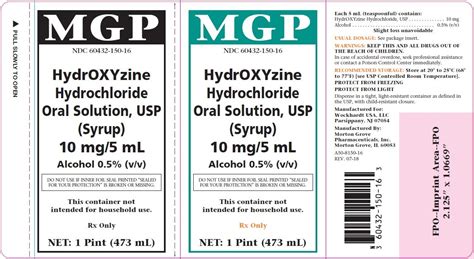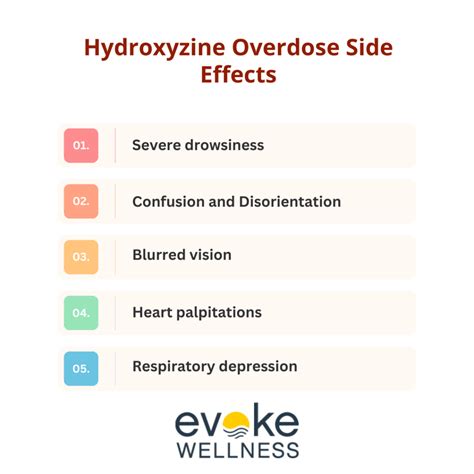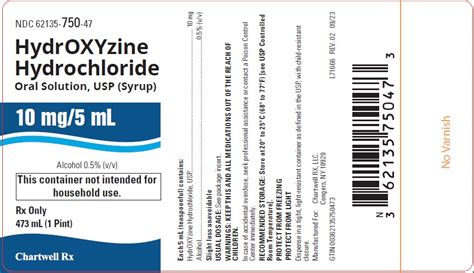Intro
Discover Hydroxyzine Hcl drug information, including uses, side effects, and interactions. Learn about this antihistamine medication, its benefits, and precautions for anxiety, itching, and allergy relief.
Hydroxyzine HCl is a medication that has been widely used for various purposes, including the treatment of anxiety and itching. Understanding its properties, uses, and potential side effects is crucial for both healthcare professionals and patients. In this article, we will delve into the details of Hydroxyzine HCl, exploring its history, pharmacology, therapeutic applications, and safety considerations.
The importance of Hydroxyzine HCl lies in its versatility as a pharmacotherapeutic agent. It belongs to the class of antihistamines, specifically the piperazine class, which also includes other compounds with diverse pharmacological activities. Initially introduced for its antihistaminic properties, Hydroxyzine HCl has found its niche in managing conditions that were not initially anticipated, such as anxiety disorders and pruritus.
Hydroxyzine HCl's mechanism of action, like other antihistamines, involves the blockade of histamine receptors. However, its anxiolytic effects are thought to be mediated through its action on the central nervous system, where it can influence the activity of other neurotransmitters. This dual action makes Hydroxyzine HCl a unique compound in the arsenal of pharmacotherapeutic agents available for treating anxiety and itching.
Introduction to Hydroxyzine HCl

Hydroxyzine HCl, or hydroxyzine hydrochloride, is a chemical compound with the molecular formula C21H27ClN2O2. It is synthesized and used in medicine for its antihistaminic and anxiolytic (anti-anxiety) properties. The drug is available in various formulations, including tablets, capsules, and injectable solutions, allowing for flexible dosing and administration routes tailored to the patient's needs.
Pharmacology of Hydroxyzine HCl
The pharmacology of Hydroxyzine HCl revolves around its ability to block histamine H1 receptors, which are involved in allergic reactions and itching sensations. Additionally, its central nervous system effects contribute to its anxiolytic properties. Understanding the pharmacokinetics and pharmacodynamics of Hydroxyzine HCl is essential for optimizing its therapeutic use and minimizing potential side effects.Therapeutic Uses of Hydroxyzine HCl

Hydroxyzine HCl is indicated for several therapeutic purposes:
- Anxiety and Tension: It is used to treat anxiety disorders, including generalized anxiety and anxiety associated with stressful situations.
- Pruritus: Hydroxyzine HCl is effective in relieving itching sensations associated with allergic conditions, such as atopic dermatitis and urticaria.
- Sedation: Due to its sedative properties, it can be used as a premedication before surgeries or procedures that require the patient to be relaxed.
- Nausea and Vomiting: In some cases, Hydroxyzine HCl may be used to manage nausea and vomiting, especially when these symptoms are related to motion sickness or vertigo.
Benefits of Hydroxyzine HCl
The benefits of Hydroxyzine HCl include its efficacy in managing anxiety and pruritus, its relatively fast onset of action, and its availability in various formulations. Additionally, its sedative effects can be beneficial in certain clinical situations. However, like all medications, it must be used under medical supervision to avoid misuse and minimize side effects.Side Effects and Safety Considerations

While Hydroxyzine HCl is generally well-tolerated, it can cause side effects, including:
- Drowsiness and sedation
- Dry mouth
- Dizziness
- Headache
- Nausea
- Constipation
In rare cases, more severe side effects can occur, such as allergic reactions, cardiac arrhythmias, and seizures, especially in susceptible individuals or when used in high doses.
Contraindications and Warnings
Hydroxyzine HCl is contraindicated in patients with known hypersensitivity to the drug or other piperazine derivatives. It should be used with caution in patients with cardiovascular diseases, glaucoma, and urinary retention. Pregnant or breastfeeding women should only use Hydroxyzine HCl under strict medical supervision due to potential risks to the fetus or baby.Interactions with Other Medications

Hydroxyzine HCl can interact with other medications, including:
- Central nervous system depressants (e.g., alcohol, sedatives, tranquilizers), which can enhance sedative effects
- Anticholinergic agents, which can increase the risk of anticholinergic side effects
- Monoamine oxidase inhibitors (MAOIs), which can lead to increased levels of Hydroxyzine HCl
It is crucial to inform healthcare providers about all medications being taken to avoid potential drug interactions.
Dosage and Administration
The dosage of Hydroxyzine HCl varies depending on the condition being treated and the patient's response. For adults, typical doses range from 50 to 100 mg orally, three to four times daily. In children, the dose is adjusted according to weight. It is essential to follow the prescribed dosage and administration schedule to achieve optimal therapeutic effects while minimizing side effects.Conclusion and Future Perspectives

In conclusion, Hydroxyzine HCl is a versatile medication with a range of therapeutic applications. Its efficacy in treating anxiety and pruritus, along with its relatively safe profile when used appropriately, makes it a valuable option in clinical practice. However, as with all medications, careful consideration of its potential side effects, interactions, and contraindications is necessary to ensure safe and effective use.
As research continues to uncover the complexities of human biology and disease, the role of Hydroxyzine HCl may evolve. Future studies may explore new indications, optimize dosing regimens, and investigate combinations with other medications to enhance therapeutic outcomes. The ongoing development of pharmacotherapeutics ensures that medications like Hydroxyzine HCl remain vital components of modern healthcare.
Final Thoughts
Hydroxyzine HCl represents a significant advancement in the management of anxiety and itching. By understanding its pharmacological properties, therapeutic uses, and safety considerations, healthcare providers can optimize its use, and patients can benefit from its efficacy. As the field of pharmacology continues to evolve, it is likely that Hydroxyzine HCl will remain a valuable tool in the treatment of various conditions, offering relief and improvement in the quality of life for many individuals.What is Hydroxyzine HCl used for?
+Hydroxyzine HCl is used for the treatment of anxiety and tension, relief of pruritus (itching) due to allergic conditions, and as a sedative.
What are the common side effects of Hydroxyzine HCl?
+Common side effects include drowsiness, dry mouth, dizziness, headache, nausea, and constipation.
Can Hydroxyzine HCl be used during pregnancy or breastfeeding?
+Hydroxyzine HCl should be used with caution in pregnant or breastfeeding women, only under the supervision of a healthcare provider, due to potential risks to the fetus or baby.
We invite you to share your thoughts, experiences, or questions about Hydroxyzine HCl in the comments below. Your engagement helps us create a more informative and supportive community for all readers. If you found this article helpful, please consider sharing it with others who might benefit from this information.
